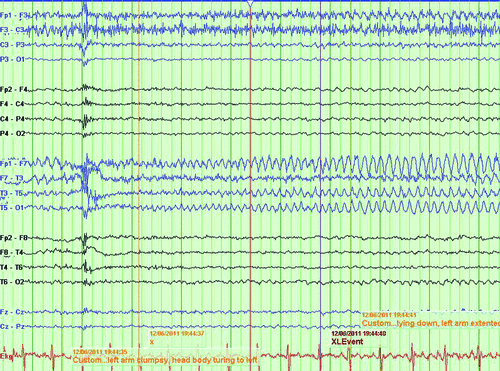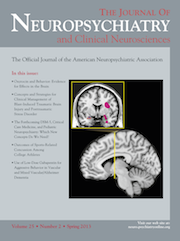Seizure With an Unusual Clinical Semiology Mimicking Psychosis: A Case Report
To the Editor: In many patients, epilepsy may coexist with a psychiatric disorder. This is easy to recognize when the patient’s underlying seizure disorder is well characterized. In a few patients, the history of seizures may either not be forthcoming or the ictal events may be characterized by extremely bizarre behavior. These patients may present to either the neurology or psychiatry services. If care is not well coordinated between these two services, such patients risk misdiagnosis and inappropriate treatment.
We present here the clinical case report of a 47-year-old woman, a resident of a shelter, whose typical events were characterized by bizarre behavior consisting of running up and down the hallway or into other residents’ rooms and having staring spells. Although she carried no formal psychiatric diagnosis and there was a remote history of seizures, she was on risperidone and sodium valproate and was being followed by her shelter’s psychiatrist. A typical event led to the ER presentation, where, initially, a diagnosis of decompensation of her psychosis was entertained. Video-EEG revealed the true ictal nature of her episodes.
Case Report
A 47-year-old homeless woman presented to our ER after bizarre behavior was observed in the shelter. Reportedly, her typical episode began by staring off into space, followed by extremely bizarre and agitated behavior, which involved running into other residents’ rooms. No loss of consciousness, tongue-bite, or urinary incontinence occurred. She had a history of seizures, had been on phenytoin and phenobarbital, but was switched to levetiracetam for unclear reasons. Sodium valproate dose was increased, and she was placed on risperidone by the shelter's psychiatrist. No formal psychiatric diagnosis was made. Multiple psychiatry ER visits were reported because of increased episode frequency. Upon arrival, the patient was pleasant and cooperative. Decompensation of her psychosis was entertained as a diagnosis, and discharge was planned with outpatient follow-up. However, soon she was found walking into another patient’s room, confused and combative.
A typical event was captured on video-EEG. The patient was awake, lying in bed, and talking on the phone. She sat up abruptly, looking confused, holding the phone with her right hand. This was followed by head and eye deviation to the left and left arm extension. Right arm semirhythmic movement was followed by nonpurposeful left hand movement. Post-ictally, she sat up, continued to look confused, and tried unsuccessfully to place the phone back on its cradle. She then began to pull and bite the telephone cord. She eventually ripped the electrode leads off her head. Electrographically at seizure onset there was a change in the background to monorhythmic 6-Hz activity over the left frontotemporal leads (Figure 1).

Discussion
Seizures may manifest with unusual clinical semiology, leading to diagnostic confusion.1 Frontal lobe seizures are at times hyperkinetic and associated with complex behavioral automatisms. Patients may jump out of bed, run around in circles, and have loud vocalization such as screaming, grunting, and laughing. Consciousness is frequently preserved during these ictal episodes, with a rapid return to pre-ictal baseline.2 Such patients may initially present to either the psychiatric or the neurology service of a hospital.3 Video-EEG use is limited in the psychiatry service. Hence, if they present to the psychiatric service, they risk being diagnosed as having psychosis and treated as such. If they present initially to the neurology service, because of the paucity of findings on the surface EEG, these are at times misdiagnosed as psychogenic nonepileptic events.
Psychiatric comorbidities of epilepsy are akin to the chicken-and-egg causality dilemma. Did the seizure disorder come first, followed by the psychiatric morbidities, or are patients with psychiatric disorders more prone to seizure disorders4? Our case report makes a strong argument for care to be extremely well coordinated between these two services to help avoid misdiagnosis and inappropriate treatment, as, frequently, either the psychiatric or seizure history may not be forthcoming. What happens more commonly is that one of these histories is not explored in detail—the psychiatric history, if the patient presents to a neurologist, and the seizure history, if the patient presents to a psychiatrist. Both neurologists and psychiatrists are guilty of looking at these patients through myopic eyes. Video-EEG can be a useful diagnostic tool to help clarify the diagnosis. The increased rate of psychiatric comorbidities predating and succeeding seizure onset suggests bidirectional relationship and common underlying mechanisms for psychiatric disorders and epilepsy.
1 : Complex behavioral automatism arising from insular cortex. Epilepsy Behav 2006; 8:315–319Crossref, Medline, Google Scholar
2 : A case with hyperkinetic frontal lobe epilepsy presenting as a psychiatric disturbance. Turk J Pediatr 2011; 53:574–578Medline, Google Scholar
3 : Temporal lobe epilepsy masquerading as psychosis - a case report and literature review. Neurocase 2011; [Epub ahead of print]Medline, Google Scholar
4 : Hospitalization for psychiatric disorders before and after onset of unprovoked seizures/epilepsy. Neurology 2012; 78:396–401Crossref, Medline, Google Scholar



